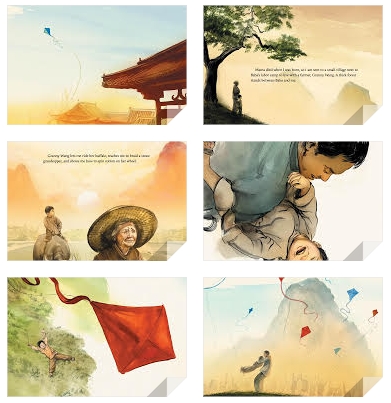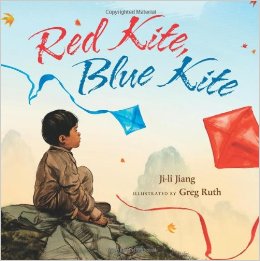|
Ji-li's Books - Red Kite, Blue Kite
Red Kite, Blue Kite
by Ji-li Jiang, Greg Ruth (Illustrations)
When Tai Shan and his father, Baba, fly kites from their roof and look down at the crowded city streets below, they feel free, like the kites. Baba loves telling Tai Shan stories while the kites--one red, and one blue--rise, dip, and soar together. Then, a bad time comes. People wearing red armbands shut down the schools, smash store signs, and search houses. Baba is sent away, and Tai Shan goes to live with Granny Wang. Though father and son are far apart, they have a secret way of staying close. Every day they greet each other by flying their kites-one red, and one blue-until Baba can be free again, like the kites.
Inspired by the dark time of the Cultural Revolution in China, this is a soaring tale of hope that will resonate with anyone who has ever had to love from a distance.

|
|

Click to
Meet-the-Author Book Reading
with Ji-li Jiang
created by
TeachingBooks.net
with thanks to Disney-Hyperion |
Editorial Reviews
The New York Times - Pamela Paul
Tai Shan and Baba's story, desperately sad (though it ends happily), is tempered by the child's sweet narrative voice, and by the luminous, dreamy landscapes rendered in Ruth's ink-and-watercolor illustrations. Ruth conveys the majestic, poetic vistas of a bygone rural and small-city China as well as the intimate configurations of Tai Shan, Baba and Granny Wang. Readers will welcome the delicious reunion at the end, while empathizing with—though not overly suffering through—Tai Shan's story during its melancholic passages.
Publishers Weekly
Ruth (A Pirate's Guide to First Grade) paints affecting closeups and dramatically lit spreads that ratchet up the tension as Tai Shan endures separation from his beloved father, Baba, who is imprisoned during China's Cultural Revolution. The days when Tai Shan and Baba flew their kites joyously from the rooftop are only a memory by the time Tai Shan ends up lodging with Granny Wang. When Baba can no longer visit, he flies his blue kite from the prison camp as a signal for Tai Shan, who flies his red kite for Baba. One day, Baba's kite doesn't appear. “Please take me to see Baba,” Tai Shan begs Granny Wang. Ruth shows Baba in his prison uniform, wan and unshaven; he has just enough time to ask Tai Shan to wait for him before his transfer to a distant camp. While Tai Shan and Baba are happily reunited, the anguish of their ordeal—which Jiang (Red Scarf Girl) portrays with scrupulous honesty—makes this introduction to Mao's China best suited for readers on the older end of the suggested age range. Ages 5–8. Agent: Caryn Wiseman, Andrea Brown Literary Agency. (Jan.)
Children's Literature - Ken Marantz and Sylvia Marantz
Our young narrator loves to fly kites. He and his father, Baba, fly them from the roof of their house in the crowded city. Tai Shan's kite is red and small; Baba's is blue and large. Then the Cultural Revolution begins in China. Schools close, and Baba is sent to a labor camp. Tai Shan must go live with Granny Wang, a farmer. Baba visits as often as he can. He tells Tai Shan to fly his kite in the morning, and he will fly his at night, as "a secret signal." But for three days, the blue kite doesn't appear. Baba comes to say goodbye. He is being sent far away. He leaves his kite for Tai Shan to fly; he will fly both kites until his Baba returns. Ruth's naturalistic illustrations effectively depict the characters and their emotions as social forces twist their lives across the double pages. The kites remain a visual symbol; we see them fly high in the landscape joyfully free to ride the winds in the troubled times until the happy ending. The author's note fills in historic background. Reviewer: Ken Marantz and Sylvia Marantz
School Library Journal
K-Gr 4—In this picture book, Jiang uses one of the unfortunate circumstances that many children had to endure to make China's Cultural Revolution somewhat understandable for young readers. Tai Shan and Baba, his father, enjoy a special private time together when they fly their kites from the roof of their home. When the revolution begins, Baba is sent to a labor camp but still manages the long walk to visit Tai Shan every Sunday. When those visits are denied, the two communicate by flying their kites-Tai Shan in the morning, Baba at sunset. In this way they remain connected: "Finally, Baba's blue kite sways into the white clouds. The kite waves at me and whispers, 'Here I am, my son.'" When even this is taken from them and before Baba is moved to a different labor camp, he escapes and visits his son. Tai Shan then flies both kites together, clinging to the connection with Baba in his mind. "The red kite follows the blue kite, forward and backward, up and down, like Baba and me, always together, never apart." While the pain of the situation is palpable, so is the sense of hope. The watercolor illustrations capture the emotional tone of the story gracefully, with the scenes from the revolution in sepia and the other background colors in gentle hues, making the brilliant colors of the kites pop. An interesting glimpse into a turbulent time, and a valuable story about love conquering distance.—Grace Oliff, Ann Blanche Smith School, Hillsdale, NJ
Kirkus Reviews
Set during the Cultural Revolution in China, a heartwarming tale of a father and son whose love never stops soaring. Tai Shan and his father, Baba, like to climb to the tippy-top of their roof and fly kites. The two kites--one red and one blue--rise and dive through the sky together. But one day, Baba is taken away to a labor camp, and Tai Shan must stay with a woman called Granny Wang, who is not his grandmother but is kind to him. A thick forest and many miles stand between father and son. Luckily, Baba devises a secret way for them to talk: Every morning, Tai Shan flies his red kite on the hill, and every evening Baba flies his blue one. The kites wave in the wind and whisper messages of comfort until the two are reunited. Ruth's muted primary palette of dusty tans and browns are a stark contrast to the few carefully placed flashes of color. The Red Guards' armbands blaze angrily, yet the two kites soaring in the sky and the bright orange leaves on the trees are spots of hope. Though this is told against the backdrop of a dark part of Chinese history, any child coping with separation from a loved one may find comfort in this story. (author's note) (Picture book. 5-8)
|





